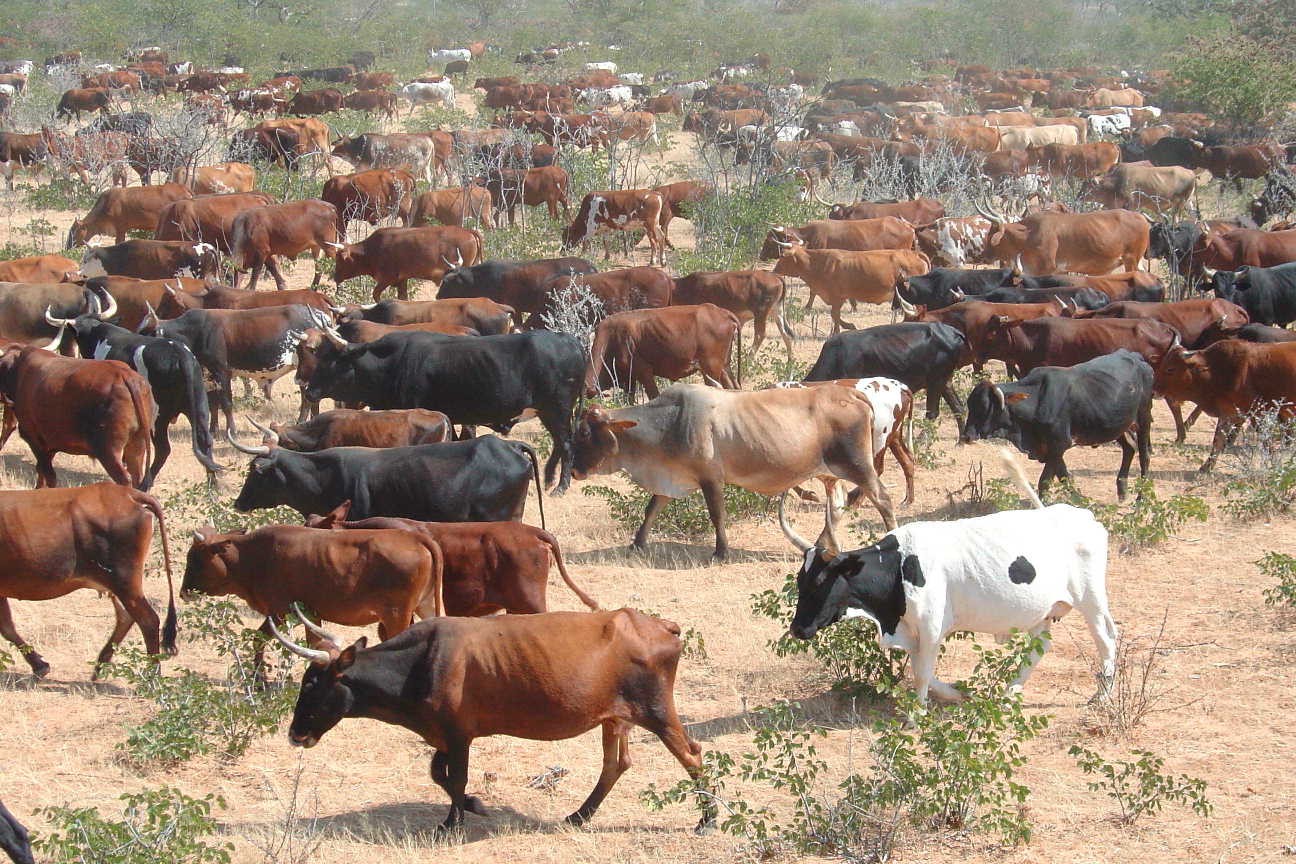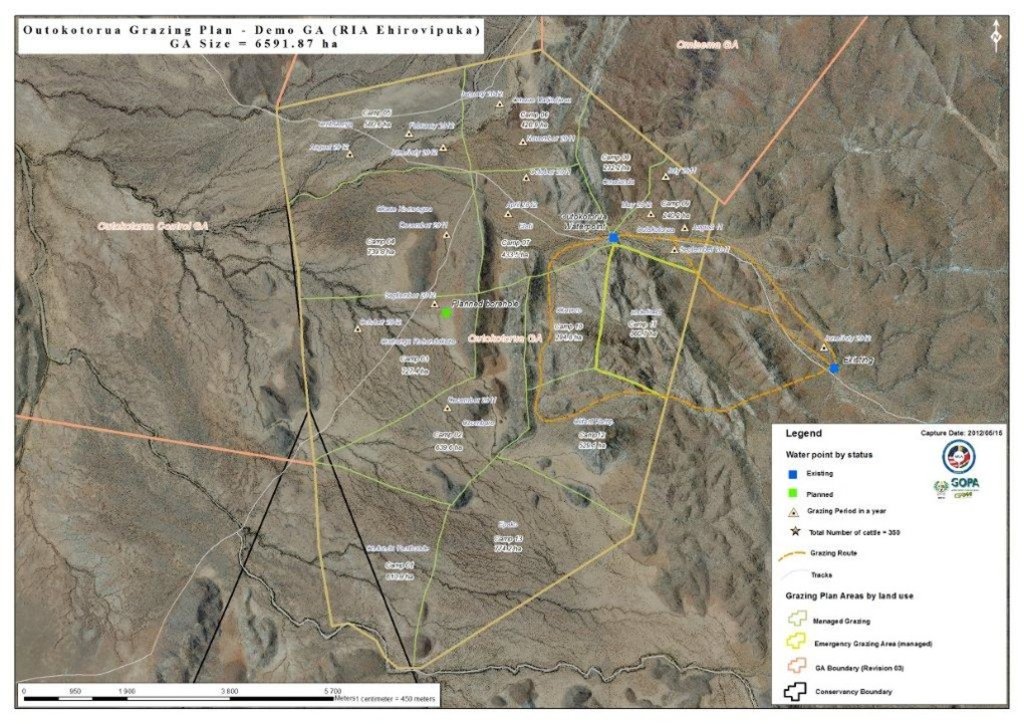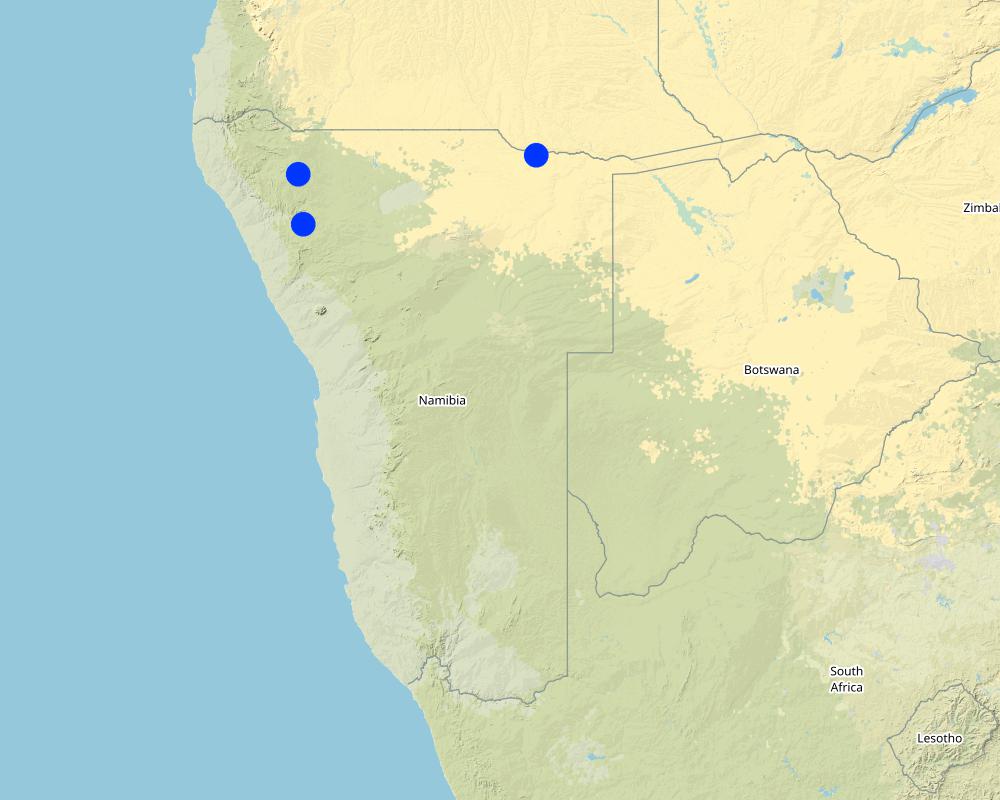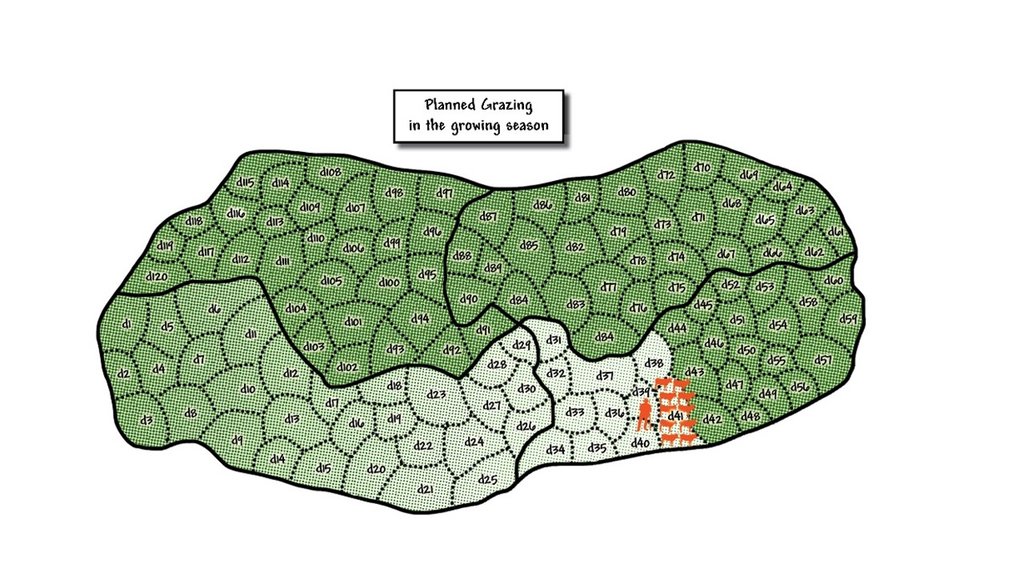Combined herding for planned grazing [Namibia]
- Creación:
- Actualización:
- Compilador: Ibo Zimmermann
- Editor: –
- Revisores: Alexandra Gavilano, Donia Mühlematter, Brigitte Zimmermann, Rima Mekdaschi Studer, Joana Eichenberger
Omarisiro wovinamuinjo motjimbumba
technologies_3326 - Namibia
- Resumen completo en PDF
- Resumen completo en PDF para imprimir
- Resumen completo en el navegador
- Resumen completo (sin formato)
- Combined herding for planned grazing: 11 de julio de 2018 (inactive)
- Combined herding for planned grazing: 11 de julio de 2018 (inactive)
- Combined herding for planned grazing: 31 de mayo de 2019 (inactive)
- Combined herding for planned grazing: 2 de noviembre de 2021 (public)
- Combined herding for planned grazing: 23 de febrero de 2018 (inactive)
- Combined herding for planned grazing: 4 de febrero de 2018 (inactive)
Visualizar secciones
Expandir todo Colapsar todos1. Información general
1.2 Detalles de contacto de las personas de referencia e instituciones involucradas en la evaluación y la documentación de la Tecnología
Especialista MST:
Especialista MST:
Nombre del proyecto que financió la documentación/ evaluación de la Tecnología (si fuera relevante)
Southern African Science Service Centre for climate change and Adaptive Land management (SASSCAL)Nombre del proyecto que financió la documentación/ evaluación de la Tecnología (si fuera relevante)
Book project: Guidelines to Rangeland Management in Sub-Saharan Africa (Rangeland Management)Nombre de la(s) institución(es) que facilitaron la documentación/ evaluación de la Tecnología (si fuera relevante)
Namibia University of Science and Technology ( NUST) - NamibiaNombre de la(s) institución(es) que facilitaron la documentación/ evaluación de la Tecnología (si fuera relevante)
Conservation Agriculture Namibia (Conservation Agriculture Namibia) - Namibia1.3 Condiciones referidas al uso de datos documentados mediante WOCAT
El compilador y la/s persona(s) de referencia claves aceptan las condiciones acerca del uso de los datos documentados mediante WOCAT:
Sí
1.4 Declaración de la sostenibilidad de la Tecnología descrita
¿La Tecnología aquí descrita resulta problemática en relación a la degradación de la tierra, de tal forma que no puede considerársela una tecnología sostenible para el manejo de la tierra?
No
1.5 Referencia al (los) Cuestionario(s) de Enfoques MST (documentados usando WOCAT)
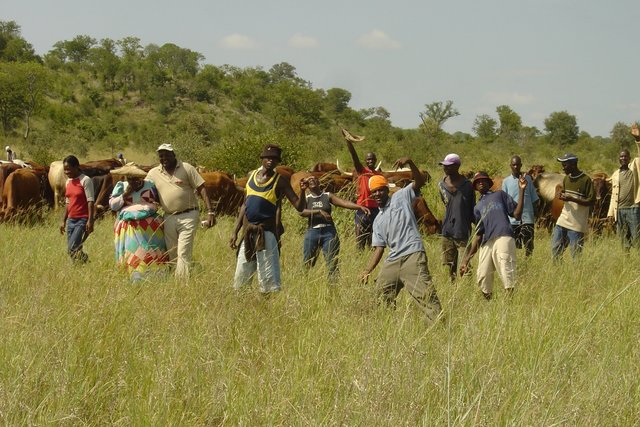
Community grazing management [Namibia]
Agreement among community members to jointly manage their communal grazing area by combining their livestock into a single herd. The herd is managed and moved according to an agreed growing season plan that provides sufficient recovery for perennial grasses, and a non-growing season plan to graze in a way that …
- Compilador: Ibo Zimmermann
2. Descripción de la Tecnología MST
2.1 Breve descripción de la Tecnología
Definición de la Tecnología:
Daily combining of livestock from all households into a single herd to be driven to different designated portions of the communal grazing area. Grass can then recover by replenishing its reserves before being re-grazed some months later.
2.2 Descripción detallada de la Tecnología
Descripción:
This technology is currently being applied in communal areas as well as commercial farms of Namibia. It is particularly effective in areas with no fences, and areas with high incidence of stock theft and predator losses. The technology aims to replace continuous, open grazing with a planned system. This gives grass a chance to recover in the growing season, and prepares the soil and grass for the forthcoming rainy season. In addition, fixed stocking rates based on carrying capacities are replaced by flexible stocking rates which track availability of forage. Two grazing plans are developed for one year; one when perennial grasses are growing and the other when they are dormant. Grazing plans may change, depending on the season and unanticipated events such as fire. A grazing plan is put in place for the growing season, that ensures plants are not re-grazed before they have recovered their root reserves. It is targeted at good animal performance . In the non-growing season, animal numbers are adjusted to ensure that there is sufficient grass to last until the next rains .
The grazing plans must take into account all factors that affect livestock performance as well as capacity of the livestock owner . These factors include occurrence of the first rains, presence of natural water pans, current and projected animal performance, availability of good quality forage for cows prior to bulling, avoiding poisonous plants, and timing of vaccinations, etc. Once the plan has been developed, the animals are moved by herders using low stress handling techniques to various parts of the farm or communal grazing area, according to the plan. Strategic moving of livestock by herding enables fire breaks to be created by deliberate over trampling. Each night the livestock are brought back to a kraal ( Afrikaans for corral) where they are kept overnight. Watering of livestock can take place in the kraal at night, in the morning, or alternatively in the field depending on water availability. This process is repeated day after day by the herders.
At the end of each growing season, the amount of forage available to the current herd is estimated. Animal numbers are adjusted to make sure that there is still sufficient forage to support them before the rains – and to leave enough ground cover to feed the soil organisms and protect the soil from erosion. Deciding when the forage produced will run out needs to be done using a method that livestock owners relate to. Livestock owners may decide to meet and reach consensus on this based on their knowledge and past experience of the effectiveness of rainfall. If it is decided that there is sufficient food to see the animals through until the next rains, then livestock owners will be satisfied; if there is excess forage they may be able to re-stock. If, however, a forage shortage is expected then de-stocking is required: the severity of the forage shortage determines how many livestock can be carried on the land during the off-season. Again, livestock owners can reach consensus on this. Deciding whose animals to sell and how many is always a thorny issue, so livestock owners will always move excess livestock to other areas if possible, or alternatively sell unproductive animals.
2.3 Fotografías de la Tecnología
2.4 Videos de la Tecnología
Comentarios, descripción breve:
Combined herding to manage communal grazing
www.youtube.com/watch?v=xNyFkDUH6MQ
Fecha:
2007
Lugar:
Erora
Nombre del videógrafo:
Andrew Botelle
Comentarios, descripción breve:
Stress-free herding
www.youtube.com/watch?v=3Ey5v40KtkI
Fecha:
2007
Lugar:
Erora
Nombre del videógrafo:
Andrew Botelle
Comentarios, descripción breve:
Managing water flow to repair gully erosion
www.youtube.com/watch?v=6C4V_Cib8ts
Fecha:
23/04/2015
Lugar:
Erora
Nombre del videógrafo:
Andrew Botelle
2.5 País/ región/ lugares donde la Tecnología fue aplicada y que se hallan comprendidos por esta evaluación
País:
Namibia
Región/ Estado/ Provincia:
Kunene Region
Especifique más el lugar :
Communal grazing areas of Erora, Outokotorua and Nsindi
Especifique la difusión de la Tecnología:
- distribuida parejamente sobre un área
Si se desconoce el área precisa, indique el área aproximada cubierta:
- 100-1,000 km2
Comentarios:
Animals are herded over the entire area – except areas that are too steep for livestock to walk up.
Map
×2.6 Fecha de la implementación
Indique año de implementación:
2004
2.7 Introducción de la Tecnología
Especifique cómo se introdujo la Tecnología:
- mediante proyectos/ intervenciones externas
Comentarios (tipo de proyecto, etc.):
Community projects facilitated by NGO "Conservation Agriculture Namibia".
3. Clasificación de la Tecnología MST
3.1 Propósito(s) principal(es) de la Tecnología MST
- mejorar la producción
- reducir, prevenir, restaurar la degradación de la tierra
- conservar el ecosistema
- proteger una cuenca hidrográfica/ áreas corriente abajo – en combinación con otras Tecnologías
- preservar/ mejorar biodiversidad
- reducir el riesgo de desastres naturales
- mitigar cambio climático y sus impactos
- crear impacto económico benéfico
- crear impacto social benéfico
- Reduce human-wildlife conflict
3.2 Tipo(s) actuales de uso de la tierra donde se aplica la Tecnología

Tierra de pastoreo
Pastoreo extenso:
- Pastoralismo semi-nómada
Comentarios:
Main animal species and products: Livestock, increased forage production, improved animal performance.
Number of growing seasons per year: 1
Livestock density: Livestock density is high as a result of herding, but stocking rate varies.
3.4 Provisión de agua
Provisión de agua para la tierra donde se aplica la Tecnología:
- de secano
3.5 Grupo MST al que pertenece la Tecnología
- pastoralismo y manejo de tierras de pastoreo
3.6 Medidas MST que componen la Tecnología

medidas de manejo
- M4: Cambios significativos en la programación de las actividades
Comentarios:
The technology does not involve a change in land use. The grazing plan means that livestock will only be on a particular piece of land twice in any given year (once in the growing season and once in the non growing season). The animal density is however high, leading to increased impact for a very short period.
3.7 Principales tipos de degradación de la tierra encarados con la Tecnología

erosión de suelos por agua
- Wt: pérdida de capa arable/ erosión de la superficie
- Wg: erosión en cárcavas
- Wo: efectos de degradación fuera del sitio

erosión de suelos por viento
- Et: pérdida de capa arable

deterioro físico del suelo
- Pk: desmoronamiento y encostramiento

degradación biológica
- Bc: reducción de la cobertura vegetal del suelo
- Bq: reducción de la cantidad/ biomasa
- Bs: reducción en la calidad y composición/ diversidad de las especies
- Bl: pérdida de la vida del suelo

degradación del agua
- Ha: aridificación
- Hs: cambio en la cantidad de aguas superficiales
- Hg: cambio en nivel de aguas subterráneas/ nivel de acuífero
Comentarios:
The control of over-trampling which otherwise leads to rill and gulley erosion.
3.8 Prevención, reducción o restauración de la degradación de la tierra
Especifique la meta de la Tecnología con relación a la degradación de la tierra:
- restaurar/ rehabilitar tierra severamente degradada
Comentarios:
Land is severely degraded but can be restored by change in management.
4. Especificaciones técnicas, actividades de implementación, insumos y costos
4.1 Dibujo técnico de la Tecnología
Especificaciones técnicas (relacionadas al dibujo técnico):
Schematic of planned growing season grazing. In this diagram grazing started in the bottom left hand camp (plot), marked d1, and the livestock were grazed in this area for one day. The next day the herd of livestock were taken to the area marked d2 and grazed there. This continued until day 41 where the livestock are currently. If deviations from the plan occur then the grazing map is marked according to what actually happened. This is the map that helps inform next year's grazing plan - to avoid using certain camps at the same time of year. The degree of greenness in the diagram indicates the recovery of grass. It is lightest in the area just grazed, marked d40. By the time the herd reaches day 120, which has the darkest green indicating readiness to be re-grazed, then the grass in the area marked d1 was calculated to have recovered sufficiently to be re-grazed. This plan has a built-in recovery period of 120 days. It is possible that growth rates are slower than expected and it may be necessary to reduce numbers of cattle in the herd to slow down movement to ensure an adequate recovery period.
Autor:
Colin Nott
4.2 Información general sobre el cálculo de insumos y costos
Especifique cómo se calcularon los costos e insumos:
- por área de Tecnología
Indique tamaño y unidad de área:
5000 ha
Especifique la moneda usada para calcular costos:
- USD
Indique el costo promedio del salario de trabajo contratado por día:
USD 4
4.3 Actividades de establecimiento
| Actividad | Momento (estación) | |
|---|---|---|
| 1. | Three meetings for mobilisation of communities | Month 1 |
| 2. | Exchange visit to local livestock owners using this practise | Month 4 |
| 3. | Assess water infrastructure, site and drill and install additional water point | Month 6 |
| 4. | Grazing planning meeting with stakeholders | After adequate grass growth to enable planned grazing |
| 5. | Appoint, equip and train herders | After 4 |
| 6. | Planning meeting and determination of starting date | After 5 |
| 7. | Build overnight kraals at new water points | When needed |
| 8. | Build temporary kraals for improved grass growth | When needed |
4.4 Costos e insumos necesarios para el establecimiento
| Especifique insumo | Unidad | Cantidad | Costos por unidad | Costos totales por insumo | % de los costos cubiertos por los usuarios de las tierras | |
|---|---|---|---|---|---|---|
| Mano de obra | Six herders (four on duty per day) for 400 cattle | Month | 6,0 | 77,0 | 462,0 | 100,0 |
| Mano de obra | One manager | Month | 1,0 | 115,0 | 115,0 | 100,0 |
| Equipo | Overalls, boots and hat that may need replacement after one year | Set | 7,0 | 100,0 | 700,0 | 100,0 |
| Material de construcción | Housing for herders built from mud and dung | Shelter | 3,0 | 100,0 | 300,0 | 100,0 |
| Otros | Laminated grazing chart and map per year | Document | 2,0 | 10,0 | 20,0 | |
| Costos totales para establecer la Tecnología | 1597,0 | |||||
| Costos totales para establecer la Tecnología en USD | 1597,0 | |||||
Si el usuario de la tierra no cubrió el 100% de los costos, indique quién financió el resto del costo:
Grazing maps and charts prodcuded by CAN (support NGO), but will be taken over soon by farmers.
4.5 Actividades de establecimiento/ recurrentes
| Actividad | Momento/ frequencia | |
|---|---|---|
| 1. | Daily herding, watering of livestock and health checks and treatment | Daily |
| 2. | Maintenance of kraals and water points | Quartery |
4.6 Costos e insumos necesarios para actividades de mantenimiento/ recurrentes (por año)
| Especifique insumo | Unidad | Cantidad | Costos por unidad | Costos totales por insumo | % de los costos cubiertos por los usuarios de las tierras | |
|---|---|---|---|---|---|---|
| Mano de obra | Six herders (four on duty per day) for 400 cattle | Month | 6,0 | 77,0 | 462,0 | 100,0 |
| Mano de obra | One manager | Month | 1,0 | 115,0 | 115,0 | 100,0 |
| Equipo | Overalls, boots and hat, replaced annually | Set | 7,0 | 100,0 | 700,0 | 100,0 |
| Material de construcción | Maintenance of clay and dung housing for herders | Shelters | 3,0 | 100,0 | 300,0 | 100,0 |
| Otros | Diesel for pumping water per month | Litres | 100,0 | 1,0 | 100,0 | 100,0 |
| Otros | Laminated grazing chart and map per year | Documents | 2,0 | 10,0 | 20,0 | 100,0 |
| Indique los costos totales para mantenecer la Tecnología | 1697,0 | |||||
| Costos totales para mantener la Tecnología en USD | 1697,0 | |||||
4.7 Factores más determinantes que afectan los costos:
Describa los factores más determinantes que afectan los costos:
Appreciation by land users that investment in herders will pay back, especially from the second year onwards.
5. Entorno natural y humano
5.1 Clima
Lluvia anual
- < 250 mm
- 251-500 mm
- 501-750 mm
- 751-1,000 mm
- 1,001-1,500 mm
- 1,501-2,000 mm
- 2,001-3,000 mm
- 3,001-4,000 mm
- > 4,000 mm
Especificaciones/ comentarios sobre la cantidad de lluvia:
Summer rainfall December-March.
Indique el nombre de la estación metereológica de referencia considerada:
Opuwo
Zona agroclimática
- árida
5.2 Topografía
Pendientes en promedio:
- plana (0-2 %)
- ligera (3-5%)
- moderada (6-10%)
- ondulada (11-15%)
- accidentada (16-30%)
- empinada (31-60%)
- muy empinada (>60%)
Formaciones telúricas:
- meseta/ planicies
- cordilleras
- laderas montañosas
- laderas de cerro
- pies de monte
- fondo del valle
Zona altitudinal:
- 0-100 m s.n.m.
- 101-500 m s.n.m.
- 501-1,000 m s.n.m
- 1,001-1,500 m s.n.m
- 1,501-2,000 m s.n.m
- 2,001-2,500 m s.n.m
- 2,501-3,000 m s.n.m
- 3,001-4,000 m s.n.m
- > 4,000 m s.n.m
Indique si la Tecnología se aplica específicamente en:
- no relevante
5.3 Suelos
Profundidad promedio del suelo:
- muy superficial (0-20 cm)
- superficial (21-50 cm)
- moderadamente profunda (51-80 cm)
- profunda (81-120 cm)
- muy profunda (>120 cm)
Textura del suelo (capa arable):
- áspera/ ligera (arenosa)
Textura del suelo (> 20 cm debajo de la superficie):
- mediana (limosa)
Materia orgánica de capa arable:
- baja (<1%)
5.4 Disponibilidad y calidad de agua
Agua subterránea:
> 50 m
Disponibilidad de aguas superficiales:
mediana
Calidad de agua (sin tratar):
agua potable de buena calidad
¿La salinidad del agua es un problema?
No
¿Se está llevando a cabo la inundación del área? :
Sí
Frecuencia:
frecuentemente
5.5 Biodiversidad
Diversidad de especies:
- mediana
Diversidad de hábitats:
- mediana
5.6 Las características de los usuarios de la tierra que aplican la Tecnología
Sedentario o nómada:
- Sedentario
- Semi-nómada
Orientación del mercado del sistema de producción:
- mixta (subsistencia/ comercial)
Ingresos no agrarios:
- 10-50% de todo el ingreso
Nivel relativo de riqueza:
- promedio
Individuos o grupos:
- grupos/ comunal
Nivel de mecanización:
- trabajo manual
Género:
- mujeres
- hombres
Edad de los usuarios de la tierra:
- personas de mediana edad
Indique otras características relevantes de los usuarios de las tierras:
In dry years all livestock may move to another cattle post. But they return to the sedentary site as their main grazing area. A significant number of land users take up employment in the nearest town.
5.7 Área promedio de la tierra usada por usuarios de tierra que aplican la Tecnología
- < 0.5 ha
- 0.5-1 ha
- 1-2 ha
- 2-5 ha
- 5-15 ha
- 15-50 ha
- 50-100 ha
- 100-500 ha
- 500-1,000 ha
- 1,000-10,000 ha
- > 10,000 ha
¿Esto se considera de pequeña, mediana o gran escala (refiriéndose al contexto local)?
- escala mediana
Comentarios:
Communal land is not owned or leased, but the community has rights to use it for agricultural purposes.
5.8 Tenencia de tierra, uso de tierra y derechos de uso de agua
Tenencia de tierra:
- estado
Derechos de uso de tierra:
- comunitarios (organizado)
Derechos de uso de agua:
- comunitarios (organizado)
Comentarios:
Land is communal and organised but no rights to enforce management are yet in place through formal structures.
5.9 Acceso a servicios e infraestructura
salud:
- pobre
- moderado
- bueno
educación:
- pobre
- moderado
- bueno
asistencia técnica:
- pobre
- moderado
- bueno
empleo (ej. fuera de la granja):
- pobre
- moderado
- bueno
mercados:
- pobre
- moderado
- bueno
energía:
- pobre
- moderado
- bueno
caminos y transporte:
- pobre
- moderado
- bueno
agua potable y saneamiento:
- pobre
- moderado
- bueno
servicios financieros:
- pobre
- moderado
- bueno
6. Impactos y comentarios para concluir
6.1 Impactos in situ demostrados por la Tecnología
Impactos socioeconómicos
Producción
producción de forraje
producción animal
riesgo de fracaso de producción
manejo de tierras
Comentarios/ especifique:
Improved, not simplified
Disponibilidad y calidad de agua
disponibilidad de agua para ganado
Ingreso y costos
gastos en insumos agrícolas
ingreso agrario
disparidades económicas
carga de trabajo
Impactos socioculturales
seguridad alimentaria/ autosuficiencia
derechos de uso de la tierra/ agua
instituciones comunitarias
MST/ conocimiento de la degradación de la tierra
mitigación de conflicto
Impactos ecológicos
Ciclo de agua/ escurrimiento de sedimento
escurrimiento superficial
evaporación
Suelo
humedad del suelo
cubierta del suelo
pérdida de suelo
encostramiento/ sellado de suelo
ciclo/ recarga de nutrientes
Biodiversidad: vegetación, animales
Cubierta vegetal
diversidad vegetal
diversidad animal
Reducción de riesgos de desastres y riesgos climáticos
impactos de sequías
riesgo de incendio
micro-clima
6.2 Impactos fuera del sitio demostrados por la Tecnología
Community's cattle no longer graze on land of neighbouring communities.
6.3 Exposición y sensibilidad de la Tecnología al cambio climático gradual y a extremos relacionados al clima/ desastres (desde la percepción de los usuarios de tierras)
Cambio climático gradual
Cambio climático gradual
| Estación | Incremento o reducción | ¿Cómo es que la tecnología soporta esto? | |
|---|---|---|---|
| temperatura anual | incrementó | moderadamente | |
| lluvia anual | disminuyó | moderadamente |
Extremos (desastres) relacionados al clima
Desastres climatológicos:
| ¿Cómo es que la tecnología soporta esto? | |
|---|---|
| tormenta local | bien |
Desastres climatológicos
| ¿Cómo es que la tecnología soporta esto? | |
|---|---|
| sequía | moderadamente |
| incendio | bien |
6.4 Análisis costo-beneficio
¿Cómo se comparan los beneficios con los costos de establecimiento (desde la perspectiva de los usuarios de tierra)?
Ingresos a corto plazo:
positivo
Ingresos a largo plazo:
muy positivo
¿Cómo se comparan los beneficios con los costos de mantenimiento/ recurrentes (desde la perspectiva de los usuarios de tierra)?
Ingresos a corto plazo:
muy positivo
Ingresos a largo plazo:
muy positivo
Comentarios:
The ability to bring back perennial grasses into the system allows higher stocking rates, less drought risk and better quality animals, therefore higher income over time and consequently a better cost-benefit analysis.
6.5 Adopción de la Tecnología
- 1-10%
Si tiene la información disponible, cuantifique (número de hogares y/o área cubierta):
20,000 ha
De todos quienes adoptaron la Tecnología, ¿cuántos lo hicieron espontáneamente, por ej. sin recibir nada de incentivos/ materiales:
- 0-10%
Comentarios:
This is a key issue undergoing lobbying of government and the communal farmers union to establish through a consultative process legislation that enables grazing plans to be enforced from within and from outside. This is lacking at the moment.
6.6 Adaptación
¿La tecnología fue modificada recientemente para adaptarse a las condiciones cambiantes?
Sí
otros (especifique):
Adaptive management
Especifique la adaptación de la Tecnología (diseño, material/ especies, etc.):
Addition of erosion control and overnight kraaling to assist with gully control. Refining re-planning in response to monitored results that deviate from aims.
6.7 Fuerzas/ ventajas/ oportunidades de la Tecnología
| Fuerzas/ ventajas/ oportunidades desde la perspectiva del usuario de la tierra |
|---|
| It is cost-effective; genuine improvement is seen in grass production, while livestock losses to predators are significantly reduced. |
| For absentee owners they can leave a manager and herders in place to get on with the work and this can be easily evaluated after time since animals wondering around leave evidence. |
| Livestock are better cared for than they used to be, and a sense of community has been restored. |
| Fuerzas/ ventajas/ oportunidades desde la perspectiva del compilador o de otra persona de referencia clave |
|---|
| This is a viable and upscaleable technology for both communal and commercial farmland in Namibia and beyond. |
| It addresses the root cause of livestock related degradation and on a larger scale could have a significant impact on mitigating climate change if all the degraded rangelands of the dry climates of the world were restored by using the principles embodied in this approach – one which has been adopted in the National Rangeland Management Policy and Strategy. Moreover it can improve the quality of lives of millions of people who live in areas where livestock is the only viable land use. |
| This is a true “triple bottom line” technology that improves the resource base whilst increasing profits and enables improved quality of life for residents. |
6.8 Debilidades/ desventajas/ riesgos de la Tecnología y formas de sobreponerse a ellos
| Debilidades/ desventajas/ riesgos desde la perspectiva del usuario de la tierra | ¿Cómo sobreponerse a ellas? |
|---|---|
| Herders are difficult to find, train and keep. | National level vocational training of herders is required. |
| Water infrastructure tends to result in overtrampling of the same routes. | The Directorate of Rural Water Supply should change its water specifications to include the provision of water for livestock – which can be cheap and effective. |
| Grass poaching takes place by neighbours and the majority will of people in an area is sometimes overrun by a small minority. | Farmers Unions must address these issues and get enforceable mechanisms in place for improved rangeland management. |
| Debilidades/ desventajas/ riesgos desde la perspectiva del compilador o de otra persona de referencia clave | ¿Cómo sobreponerse a ellas? |
|---|---|
| There is insufficient national buy-in from line ministries in terms of implementation to address many of the issues that have been raised. | Line ministries should support implementation to address these problems. Joint implementation, joint review and adaptation by government, unions, livestock owners and support providers will assist in solving many issues for resource-base improvement. |
7. Referencias y vínculos
7.1 Métodos/ fuentes de información
- entrevistas con especialistas/ expertos en MST
¿Cuándo se compilaron los datos (en el campo)?
20/06/2017
7.2 Vínculos a las publicaciones disponibles
Título, autor, año, ISBN:
Holistic mangement, Savory, A. & Butterfield, J., 1991
¿Dónde se halla disponible? ¿Costo?
Island Press
7.3 Vínculos a la información relevante disponible en línea
Título/ descripción:
Volkmann, W. (2011). Community based rangeland and livestock management. Windhoek: GOPA-CBRLM.
URL:
https://rmportal.net/groups/cbrlm/cbrlm-for-review/namibia-community-based-rangeland-livestock-management-cbrlm-2nd-edition/view
Vínculos y módulos
Expandir todo Colapsar todosVínculos

Community grazing management [Namibia]
Agreement among community members to jointly manage their communal grazing area by combining their livestock into a single herd. The herd is managed and moved according to an agreed growing season plan that provides sufficient recovery for perennial grasses, and a non-growing season plan to graze in a way that …
- Compilador: Ibo Zimmermann
Módulos
No se hallaron módulos


